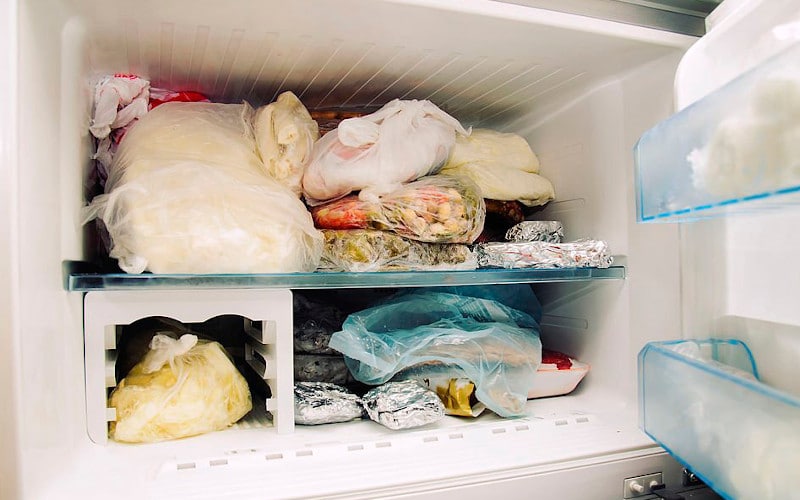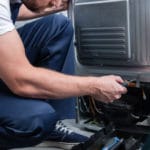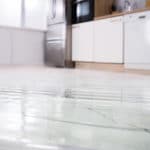If your GE freezer isn’t freezing, you’re likely feeling frustrated. A freezer that doesn’t freeze is a huge inconvenience – not to mention, it can lead to food spoilage and wasted money.
In this blog post, we will discuss some common causes of a GE freezer not freezing and provide troubleshooting tips to help you get your freezer back up and running ASAP.
What are the Common Causes of a GE Freeze Not Freezing?
There are several common causes of a GE freezer not freezing. Some of the most common include:
- A blocked or clogged condenser coil
- Evaporator fan motor not working
- Start relay is not working
- Defrost heater won’t turn on
- Condenser fan motor is not running
- Broken main control board
- Defective temperature control thermostat
- Defective user control and display board
- Compressor is not working
- Sealed system is leaking
How Do I Troubleshoot My GE Freezer Not Freezing?
Solution 1: A Blocked or Clogged Condenser Coil
The condenser coils do not require cleaning if they are within the freezer walls. If the condenser coils may be accessed from behind or under the unit, they should be cleaned every 6-12 months. Cleaning the condenser coils will increase their ability to dissipate heat, which will boost the freezer’s cooling capacity.
If your condenser coils are blocked or clogged, follow these steps to clean them:
- Unplug the freezer from the power outlet.
- Remove any food items from the freezer.
- Locate the condenser coils. They are usually located behind or under the unit.
- Vacuum the coils with a brush attachment to remove dirt and debris.
- Wipe the coils with a clean cloth soaked in warm water.
- Dry the coils thoroughly before plugging the freezer back in.
Solution 2: Frost on the Evaporator Coils
Check the evaporator coils if your GE freezer is not freezing. The efficiency of the evaporator coils can be reduced by frost on them. The cold air that makes the freezer freeze is created by the coils. If there is dust on them, they will perform worse. In a similar way, if they are dirty, they will function improperly.
Remove everything from the freezer and defrost it manually. Perishable goods should be stored in a different freezer or wrapped in newspaper for later use.
Leave the freezer door open for approximately 24 hours to allow it to completely thaw. The frost on the coils will be taken care of as a result of this.
The defrost heater is the most likely faulty component, as it controls when the freezer’s evaporator coils are cooled. So check for continuity using a multimeter on the defrost heater. Replace the heater if there isn’t any continuity, but test the defrost timer if there is.
Solution 3: Evaporator Fan Motor is not Working
If the evaporator fan motor is not working, the freezer will not be able to circulate cold air, which will cause the freezer to stop freezing.
To troubleshoot this problem, follow these steps:
- Unplug the freezer from the power outlet.
- Remove any food items from the freezer.
- Locate the evaporator fan motor. It is usually located in the back of the freezer near the coils.
- Test the evaporator fan motor with a multimeter to see if it is receiving power.
- If the evaporator fan motor is receiving power, test it for Continuity using a multimeter. If there is no continuity, the evaporator fan motor will need to be replaced.
Solution 4: Start Relay is Not Working
The start relay is responsible for supplying power to the compressor. If the start relay is not working, the compressor will not be able to start.
To troubleshoot this problem, follow these steps:
- Unplug the freezer from the power outlet.
- Remove any food items from the freezer.
- Locate the start relay. It is usually located on the side of the compressor.
- Test the start relay for Continuity using a multimeter. If there is no continuity, the start relay will need to be replaced.
Solution 5: Temperature Control Thermostat is Faulty
The thermostat regulates the supply of electricity to the fan and compressor motors. If it’s unable to do so, the refrigerant system will not function correctly. As a result, the freezer will not cool or freeze.
To troubleshoot this problem, follow these steps:
- Unplug the freezer from the power outlet.
- Remove any food items from the freezer.
- Locate the thermostat. It is usually located on or near the evaporator coils.
- Test the thermostat for Continuity using a multimeter.
- If there is no continuity, the thermostat will need to be replaced.
In extremely rare circumstances, the problem might be caused by the compressor, the user control and display board, or the main control board. The leaky sealed system is even more unusual. However, it can happen.
Check all of the components listed above to ensure that they are not faulty, then check for leaks in the boards, compressor, and sealed system.
Solution 6: Defrost Heater Won’t Turn On
The defrost heater is responsible for melting any frost that has built up on the evaporator coils. If the defrost heater won’t turn on, the frost will build up and prevent the evaporator coils from doing their job.
To troubleshoot this problem, follow these steps:
- Unplug the freezer from the power outlet.
- Remove any food items from the freezer.
- Locate the defrost heater. It is usually located behind the evaporator coils.
- Test the defrost heater for Continuity using a multimeter.
- If there is no continuity, the defrost heater will need to be replaced.
Solution 7: Condenser Fan Motor is not Running
The condenser fan motor is responsible for circulating air over the condenser coils. If the condenser fan motor is not running, the freezer will not be able to dissipate heat, which will cause the freezer to stop freezing.
To troubleshoot this problem, follow these steps:
- Unplug the freezer from the power outlet.
- Remove any food items from the freezer.
- Locate the condenser fan motor. It is usually located behind or under the unit.
- Test the condenser fan motor for Continuity using a multimeter.
- If the condenser fan motor is not receiving power, or if there is no continuity, the condenser fan motor will need to be replaced.
Conclusion
These are the most common solutions to a GE freezer not freezing. If you have tried all of these solutions and your freezer still is not freezing, you may need to call a professional for help.
Thanks for reading!






